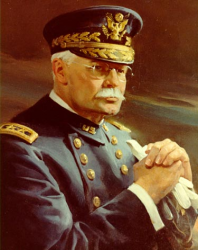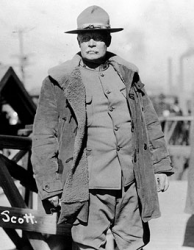
 |
|
|
||
|
Hugh Lenox Scott |
||||
|
Graduate, U.S. Military Academy, Class of 1876 |
||||
| Biography: | ||||
|
Hugh Lenox Scott Hugh Lenox Scott was born on 22 September 1853 in Danville, KY. Scott grew up there and in Princeton, NJ, where he attended The Lawrenceville School. Scott graduated from the U.S. Military Academy in 1876 (his Cullum Number was 2628), and was commissioned as a Second Lieutenant in the Cavalry. For some twenty years thereafter he served on the Western frontier, chiefly with the 7th U.S. Cavalry. He was assigned to the quarters that had only recently been vacated by the widow of George Armstrong Custer. In fact, Scott was sent out to the Little Big Horn battle site to mark gravesites for Custer's men killed in the battle. He also had the opportunity to interview many of the Native Americans who fought on both sides on that hot 25 June 1876 day. He saw action in campaigns against the Sioux, Nex Perce, Cheyenne and other Indians of the Plains and became an expert in their languages and ways of life. He was promoted to First Lieutenant in June 1878. In 1890-91 he was given the responsibility of suppressing the "Ghost Dance" religious movement that swept the Indian Reservations and received an official commendation for that work. In 1892, he organized Troop L of the 7th Cavalry, composed of Kiowa, Comanche and Apache Indians, and commanded it until it was mustered out, the last Indian Troop in the U.S. Army in 1897. In 1894-97, he had charge of Geronimo's band of Chiricahua Apache Indian prisoners at Fort Sill, OK. He was advanced to Captain in January 1895. In November 1897, he was attached to the Bureau of American Ethnology of the Smithsonian Institution, where he began preparing a work on Indian sign languages. In May 1898, after the outbreak of the Spanish-American War, he was appointed Major of Volunteers and Assistant Adjutant General of the 2nd and 3rd Divisions, I Corps. He saw no action in that war, but in March 1899 went to Cuba as Adjutant General, Department of Havana, with the rank of Lieutenant Colonel of Volunteers. In May 1900 he moved up to Adjutant General of the Department of Cuba and remained in that post until May 1902. During that time he served for a time as Acting Governor and took an active part in the transfer of government into Cuban hands. He was promoted to Major of Regulars in February 1903 and served as Military Governor of the Sulu Archipelago, Philippines, in 1903-06 and also commanded troops there, taking part in various skirmishes and reorganizing the civil government and institutions. In August 1906, he was named Superintendent of the U.S. Military Academy, a post he held for four years with the temporary rank of Colonel. He was promoted to regular Lieutenant Colonel in March 1911 and to Colonel in August. He then commanded the 3rd U.S. Cavalry in Texas, engaged in settling various Indian troubles. In March 1913, he was promoted to Brigadier General in command of the 2nd Cavalry Brigade, still posted to the Southwest. He won special commendation for his skillful handling of Navajo disturbances at Beautiful Mountain, AZ, in November 1913. He was named Assistant Chief of Staff in April 1914 and Chief of Staff of the U.S. Army from 1914-17, including the first few months of American involvement in World War I. He was promoted to Major General in April 1915. He continued to act in a diplomatic role with Indians and Mexican Border officials in the Southwest, settling problems with the Piutes of Utah in March 1915 and recovering property "confiscated" by Pancho Villa in August. In February-March 1916, he served as Ad-Interim Secretary of War. But his energy was directed more toward preparation for possible U.S. entry into World War I, and he was very influential in winning early acceptance among civil officials of the notion of conscription. He retired at the statutory age in September 1917 but remained on active duty. He became commander of the 78th Division at Camp Dix, NJ, in December and of Camp Dix again in March 1918. He finally retired in May 1919. He served on the Board of Indian Commissioners from 1919-29 and was Chairman of the New Jersey State Highway Commission from 1923-33. In 1928 he published an autobiography, "Some Memories of A Soldier." Honors • The transport ship USS Hugh L. Scott was named in his honor. • Scott Middle School in Fort Knox, KY, is also named for Major General Scott. Death and Burial Major General Hugh Lenox Scott died on 30 April 1934 in Washington, DC. He is buried at Arlington National Cemetery in Arlington, VA. |
||||
| Honoree ID: 3055 | Created by: MHOH | |||
Ribbons
Medals
Badges
Honoree Photos
 |  |  |
 |  |
 |


